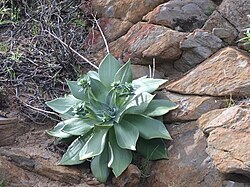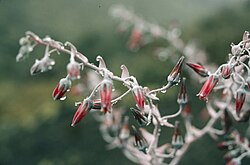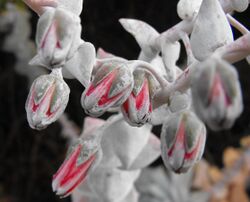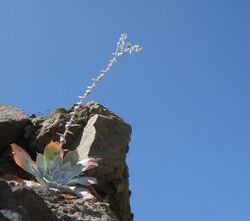Biology:Dudleya pulverulenta
| Chalk dudleya | |
|---|---|

| |
| Scientific classification | |
| Kingdom: | Plantae |
| Clade: | Tracheophytes |
| Clade: | Angiosperms |
| Clade: | Eudicots |
| Order: | Saxifragales |
| Family: | Crassulaceae |
| Genus: | Dudleya |
| Species: | D. pulverulenta
|
| Binomial name | |
| Dudleya pulverulenta | |
| Synonyms | |
| |
Dudleya pulverulenta is a species of perennial succulent plant known by the common names chalk lettuce, chalk dudleya, and chalk liveforever. It is one of the largest Dudleya, with a silvery, waxy rosette that may greatly contrast with its habitat. It is also regarded as one of the most distinctive members of the Dudleya, with the most advanced inflorescence in the genus,[2] consisting of pendant, hummingbird pollinated flowers, the longest corolla, and the highest nectar output, along with the largest range of all the Dudleya, over 1,000 kilometres (620 mi), being found from southern Monterey County in California to the Sierra de San Borja in southern Baja California.[3]
Description
Dudleya pulverulenta is a rosette-forming, succulent species of plant, covered in a distinctive chalky and mealy wax, known as a farina, or more technically, epicuticular wax. It is one of the largest species of Dudleya. All parts of the inflorescence are covered in a chalky wax, and the flowering stems may reach up to 150 cm (59 in) long. The long, red flowers hang downward, an adaptation to hummingbird pollinators. After flowering, the fruits are turned erect by a sharp turn of the branchlet, known as a pedicel, connecting the flower to the inflorescence. This unique syndrome is only shared by Dudleya anthonyi, a close relative,[3] and Dudleya rigida, an extremely rare species found in far southern Baja California Sur.[4] Dudleya arizonica is similar in appearance, and approaches D. pulverulenta in many aspects, but lacks the downward-pointing flowers and unique fruiting behavior, instead having erect flowers and a more reduced size.[5]
Morphology
Dudleya pulverulenta grows a thick caudex, 4–10 cm (1.6–3.9 in) wide. As the plant grows older, the stem gradually becomes decumbent. The stem is densely clothed with old, dried leaves. Atop this stem is a solitary rosette, as the stems do not form axillary branches. The rosette reaches a width of 7–60 cm (2.8–23.6 in), and is composed of 40 to 60 wide, flat, fleshy, chalky white leaves which age to a pinkish papery texture. The leaves are shaped oblong, broadest at the base or upper third, with the tip acuminate to mucronate, or acute. The leaves are 8–25 cm (3.1–9.8 in) long by 3–10 cm (1.2–3.9 in) wide, and are 3–10 mm (0.12–0.39 in) thick. The epidermis of the plant is covered with a dense coating of chalky, powdery epicuticular wax.[3][6][7][8]
The peduncle is 30–100 cm (12–39 in) tall by 5–20 mm (0.20–0.79 in) wide, and is covered in 20 to 70 bracts. The bracts are spreading to deflexed, and are shaped cordate-ovate to suborbiculate, with an acuminate tip. The bracts measure 20–50 mm (0.79–1.97 in) long by 15–30 mm (0.59–1.18 in) wide, and may be a reddish color. The peduncle branches into 2 to 6 branches, which may or may not rebranch. There are 2 to 5 terminal branches, known as cincinni, that are nodding in youth but become spreading in age, and measure 10–50 cm (3.9–19.7 in) long. The cincinni are circinate, unfurling like the frond of a fern. The cincinni hold 10 to 30 flowers, and are twisted at the base, so that the flowers are on the underside.[3][8]
Suspending the flowers pendant are the pedicels, which measure 10–35 mm (0.39–1.38 in) long. In age, the pedicels sharply bend in the near middle to bring the fruits to a more or less erect position. The calyx measures 5–9 mm (0.20–0.35 in) long by 5–8 mm (0.20–0.31 in) wide, with mostly acute sepals. The petals are 11–19 mm (0.43–0.75 in) long, and united for 6–10 mm (0.24–0.39 in) along their length. The apex of the petals is shaped acute to obtuse, with the tips erect. The sepals are waxy, while the petals are red, with some wax.[3][7][8]
Dudleya pulverulenta flowers in early summer, usually from May to July.[3][8] Plants subject to full sun close their rosettes during the summer, and in July to August the leaves will begin to fold upward and inward, "shrinking" in the heightened temperatures. Plants on north-facing or shaded slopes are less likely to close their rosettes.[6]
Phytochemistry
Higher temperatures are tolerated well by Dudleya because of their epicuticular wax, which reflects light and prevents evaporation of water droplets.[9][10]
Taxonomy
The type specimen was collected by Thomas Nutall in San Diego, in May 1835.[7] Dudleya puvlerulenta hybridizes with Dudleya lanceolata where they overlap in their ranges.[8]
Characteristics
Dudleya pulverulenta intergrades with both Dudleya anthonyi and Dudleya arizonica, and the boundaries between these three entities are not always clearly defined. Dudleya brittonii bears a superficial resemblance to this species, but differs significantly in its smaller yellowish-white flowers and dense inflorescence.[11] Two charts (below) compares the characteristics of these four species.
| Species | Dudleya pulverulenta | Dudleya anthonyi | Dudleya arizonica | Dudleya brittonii |
|---|---|---|---|---|
| Image |  |

|

|

|
| Rosette width | 7–60 cm (2.8–23.6 in)[8] | 15–50 cm (5.9–19.7 in)[11] | 10–25 cm (3.9–9.8 in)[12] | 10–50 cm (3.9–19.7 in)[11] |
| # of leaves | 40–60[8][11] | 35–90,[11] 40–60[13] | 15–25[11][12] | 40–120[11] |
| Leaf shape | Oblong, usually widest in distal 1⁄3[3][11] | Oblong, widest at base[11] | Oblong-oblanceolate to oblong-ovate[11][12] | Linear to oblong-lanceolate[11] |
| Leaf tip | Acuminate, mucronate, to acute[8][11] | Acuminate or sharply acute[13] | Long-acuminate[12] | Long-acuminate[11] |
| Species | Dudleya pulverulenta | Dudleya anthonyi | Dudleya arizonica | Dudleya brittonii |
|---|---|---|---|---|
| Image |  |

|

|

|
| Peduncle length | 30–100 cm (12–39 in),[3][8] 30–80 cm (12–31 in)[11] | 40–70 cm (16–28 in),[11] 30–70 cm (12–28 in)[13] | 15–60 cm (5.9–23.6 in)[12] | 30–100 cm (12–39 in)[11] |
| # of fls. per cincinni | 10–30[3][11] | 12–25[11] | 3–6,[11][12] 4–20[5] | 5–20[11] |
| Pedicel length | 5–30 mm (0.20–1.18 in),[8][11] 10–35 mm (0.39–1.38 in)[3] | 12–15 mm (0.47–0.59 in)[11][13] | 5–15 mm (0.20–0.59 in),[12] 5–20 mm (0.20–0.79 in)[5] | 6–15 mm (0.24–0.59 in)[11] |
| Pedicels at anthesis | Pendent[3][8][11] | Pendent[11] | Erect, ascending, rarely spreading to pendent[12][11][5] | Erect[11] |
| Petal color | Red, with some wax[8][3] | Deep red[11][13] | Red to apricot yellow[5][12] | Yellowish-white[11] |
| Sepal shape | Triangular to triangular-ovate, acute[11] | Triangular-lanceolate to linear, pointed[11] | Acute[11] | Long-lanceolate, acute[11] |
Distribution and habitat
Dudleya pulverulenta is native to California and Baja California. Its range extends from extreme southern Monterey County[14] southward to Punta Prieta in the central desert of Baja California.[15] It is typically found in rocky cliffs, and canyons, generally under 1000 meters in elevation.[8] It is primarily a plant of coastal distribution and can often be found within 12 miles of the coast, and more inland occurrences are typically in valleys where the heat is moderated by elevation or coastal influence.[6]
Plants are very rapid recolonizers as evidenced by proliferation on roadcuts or disturbed soil shortly after development.[6] Their habitat preference for rocky, shallow soils and open habitats mean that fuel is limited in proximity to the plants, enabling them to survive wildfire. The plant will resprout after fire.[16]
Cultivation
The plant tolerates full sun exposure or part shade. It is susceptible to aphid infestations which result in flower and rosette deformities.[6] It is a much hardier plant for the garden environment than the more commonly available Dudleya brittonii.
Dudleya pulverulenta is not noted for its longevity and may only live up to 2 or 3 years in cultivation, but some specimens in the wild may be over 40 years old in a most optimal location. When the plant dies, the rosette takes on a withered, ashy gray appearance, resembling a bird's nest. It is important to note whether the center leaves of the rosette are still alive, as the dormant plant will often surround a few live leaves with a ring of withered leaves until the next growing season pushes them down.[6]
See also
References
- ↑ "Dudleya pulverulenta". NatureServe. 2022. https://explorer.natureserve.org/Taxon/ELEMENT_GLOBAL.2.158431/Dudleya_pulverulenta.
- ↑ Moran, Reid. "Dudleya". Flora of North America 8: 171. http://floranorthamerica.org/Dudleya.
- ↑ 3.00 3.01 3.02 3.03 3.04 3.05 3.06 3.07 3.08 3.09 3.10 3.11 Moran, Reid. "Dudleya pulverulenta". Flora of North America 8: 191. http://floranorthamerica.org/Dudleya_pulverulenta.
- ↑ Moran, Reid (1987). "Dudleya rigida Rose". Cactus and Succulent Journal of America 1987 Sep-Oct: 187–194.
- ↑ 5.0 5.1 5.2 5.3 5.4 Moran, Reid. "Dudleya arizonica". Flora of North America 8: 178, 190–191. http://floranorthamerica.org/Dudleya_arizonica.
- ↑ 6.0 6.1 6.2 6.3 6.4 6.5 Thomson, Paul H. (1993). Dudleya and Hasseanthus Handbook. Bonsall Publications. ISBN 9780960206650.
- ↑ 7.0 7.1 7.2 Moran, Reid V. (1943). "Dudleya Pulverulenta (Nutt.) Br. & R.". Desert Plant Life.
- ↑ 8.00 8.01 8.02 8.03 8.04 8.05 8.06 8.07 8.08 8.09 8.10 8.11 8.12 McCabe, Stephen Ward (2012). "Dudleya pulverulenta". Jepson Flora Project. https://ucjeps.berkeley.edu/eflora/eflora_display.php?tid=23669.
- ↑ Mulroy, Thomas W. (1979). "Spectral Properties of Heavily Glaucous and Non-Glaucous Leaves of a Succulent Rosette-Plant". Oecologia 38 (3): 349–357. doi:10.1007/BF00345193. PMID 28309493. Bibcode: 1979Oecol..38..349M.
- ↑ Mulroy, T. W. (1976). The Adaptive Significance of Epicuticular Waxes in Dudleya (Crassulaceae). University of California, Irvine.
- ↑ 11.00 11.01 11.02 11.03 11.04 11.05 11.06 11.07 11.08 11.09 11.10 11.11 11.12 11.13 11.14 11.15 11.16 11.17 11.18 11.19 11.20 11.21 11.22 11.23 11.24 11.25 11.26 11.27 11.28 11.29 11.30 11.31 11.32 Eggli, Urs, ed (2003). "Dudleya". Illustrated Handbook of Succulent Plants: Crassulaceae. Springer. pp. 85–103. doi:10.1007/978-3-642-55874-0. ISBN 978-3-642-62629-6.
- ↑ 12.0 12.1 12.2 12.3 12.4 12.5 12.6 12.7 12.8 McCabe, Stephen Ward (2012). "Dudleya arizonica". Jepson Flora Project. https://ucjeps.berkeley.edu/eflora/eflora_display.php?tid=23638.
- ↑ 13.0 13.1 13.2 13.3 13.4 Moran, Reid (1943). "Dudleya anthonyi". Desert Plant Life.
- ↑ McCabe, Stephen Ward (26 September 2019). "Succulent Poaching, Conservation,and the Mainland Dudleyas". CNPS Santa Clara Valley Chapter. https://www.youtube.com/watch?v=aRVj06kE9qY.
- ↑ Rebman, J. P.; Gibson, J.; Rich, K. (2016). "Annotated checklist of the vascular plants of Baja California, Mexico". San Diego Society of Natural History 45: 133. http://sdplantatlas.org/pdffiles/BajaChecklist2016.pdf.
- ↑ Kellog, E (May 2005). "Post-fire Monitoring and Management Strategy for Blossom Valley Habitat Conservation Area". Center for Natural Lands Management (Tierra Data, Inc): 23. https://sdmmp.com/upload/SDMMP_Repository/0/MP8_Kellogg_2005_TierraDataInc_CNLM_Blossom_ValleyHCA.pdf.
External links
- [1]
- Jepson Manual Treatment of Dudleya pulverulenta
- USDA Plants Profile for Dudleya pulverulenta
- U.C. Photos gallery − Dudleya pulverulenta
Wikidata ☰ Q5226268 entry
 |





